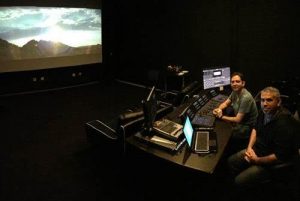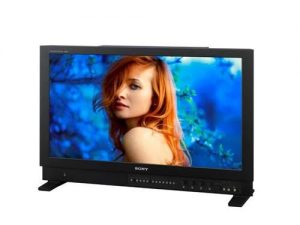Sony’s BVM-X300 Master Monitor Boosts Roundabout Entertainment
Story Highlights
Roundabout Entertainment is a full-service post-production facility in Burbank that works with clients like Amazon, Fox and Paramount on projects ranging from blockbusters to OTT programming and indie flicks. In this realm, HDR and 4K are the expectation, so the team at Roundabout needs to use the best tools to provide the high quality work and standards their customers have come to expect.
For Roundabout, the products that allow them to stay up-to-date with new trends include Sony’s flagship BVM-X300 30-inch 4K OLED master monitor, which combines 4K resolution, High Dynamic Range (HDR) and wide color gamut.
In addition, the company recently updated their resources to include Sony’s PVM-X550 4K 55-inch quad-view OLED client monitor, showcasing their commitment to the latest in technology and serving as a testament to their success with Sony’s monitors. The team at Roundabout explained their roles and responsibilities in the post-production workflow, and how Sony’s newest monitor offerings help them exceed their clients’ expectations.

Roundabout’s Michael Smolin and Juan Zorn
Michael Smolin – Senior Colorist
As Senior Colorist for Roundabout Entertainment, our team needs to use the best tools to provide the high quality work and standards our customers have come to expect. For my fellow colorists and colleagues in quality control, the tools that allow us to stay up to date on the latest technology include Sony’s flagship BVM-X300 master monitor.
Roundabout uses Sony’s BVM-X300 to QC all of our Amazon deliverables, in addition to use on restoration projects and for finishing features. As HDR has become an integral part of our workflow, we have had to adopt different standards which require us to produce new deliverables, in a new color space. Our clients like the aesthetic HDR offers – its depth and brighter, more vivid colors. The darker blacks, whiter whites, deeper shadows and enhanced detail is rapidly becoming an attractive feature.
While theaters have embraced the technology, HDR is still being adopted by consumers in their homes. This requires us to make deliverables in Rec 709 for home viewing and P3 for the cinema experience. In most instances, viewers will see the P3 for features in theaters and the Rec 709 at home on TV shows, as HDR becomes more mainstream.
With the Sony BVM-X300 monitor, we finally have something that supports color-critical work through a combination of the latest technologies and provides a number of beneficial features at a reasonable price point. As we navigate this new terrain, we appreciate the flexibility the BVM-X300 offers us in all of these instances. Regardless of the client’s requirements, we know the X300 can meet them. The monitor does 4K. It does 2K. It does HD. It does P3, XYZ and 709. It covers all the color spaces and it is “no LUT,” so it gets really black. That’s something you don’t get from a plasma or LCD monitor. The true blacks produced by the X300 are essential for color-critical grading. Most facilities use plasmas for grading, but unless you are using them in dynamic mode, you cannot get the brightness required for 709 grading.
Currently we use our BVM-X300 on its own, but we like that it has the ability to work alongside the several Sony PVM-X550 55-inch 4K OLED client monitors already in use in our facility for grading in 709. One allows us to show HDR and the other offers a large size, for easy client viewing, so they work well when used in tandem.

Sony’s BVM-X300
Overall, we want to meet our client’s demands and offer options that meet their standards – whatever they may be. The X300 allows us to do this, while also giving us the ability to future-proof the pieces we are working on. While viewers may not necessarily see the brightness of HDR in their home just yet, it will soon become the standard expectation and we have already prepared the content for when that day comes.
Juan Zorn – Colorist
As a Colorist for Roundabout I’ve used Sony’s BVM-X300 while doing restoration work for Paramount and Disney, as well as some commercial projects. More clients are asking to implement the newest technological advancements so they are ahead of the curve and well prepared for the future. Customers want the added vibrancy of a wide color gamut. While they don’t often notice differences in color or quality, they immediately recognize the difference that HDR offers. Once they see how vivid the colors are, they’re sold. Lately, we are adding HDR sessions to more and more projects as it becomes commonplace. Our clients find HDR content more realistic and true to life. As a colorist, I appreciate the greater range of color, which allows you to go in new and different directions.
After the buzz surrounding the BVM-X300 at NAB Show 2015, we demoed the monitor at our facility and compared it to several other competing options. The X300 was the obvious choice. It had the best picture, it hit all the ranges and the price point made us happy. It offered the best of everything.
We were really excited by this new product because of all of the advancements it combines into one package. It increases all of the ranges. The resolution is better. It looks beautiful on a big screen. It can do HD and 2K. When we go from HD to 4K, it’s like you’re working with a different monitor. The colors are so vivid, so bright, and seem to go on forever – plus there’s so much detail. You can push the monitor to extremes and it holds. I love the range of options the BVM-X300 gives you.
It’s also saved us in situations another monitor might not catch. We were doing some effects work recently, and we were able to spot some issues that suggested it was the wrong output file. The difference was minute, but we did catch it thanks to the X300.
Jesse Hansen – QC Manager
For quality control in our facility, we currently use three of Sony’s BVM-X300 monitors for 4K and HDR work, alongside a transcoder for HDR files and an additional monitor to make the files for QC in Final Cut. And it’s not only QC that has taken a liking to the monitors – our colorists also love them and want their own X300. At Roundabout, these models replaced a Samsung 60-inch curved monitor. With our new Sony setup, it’s night and day from our past experiences. I’ve found that I am able to get more work done faster and more efficiently because I don’t have to change between monitors to view and finalize 4K and HDR content.
With the BVM-X300, the quality of the monitor is evident, the functions are easy to use, the picture quality is unmatched and in HDR, the range of the colors is so great, especially the shadow detail and saturation, and this extra information allows you to choose many different paths for the ultimate look of the content. For example, everything is easier to see – camera pixels and film dirt really pop out in HDR, and on our previous monitors, you could barely see these imperfections. HDR on the X300 is awesome, showcasing deep and vibrant colors that come to life and offering content creators and post-production professionals more creative freedom and artistic expression. We’ve even had people walk through our facility ask about the BVM-X300s because the colors are so beautiful.
Another valuable aspect of the increased amount of detail and the picture quality that the monitor offers is the time it saves. We are able to do high quality work and catch issues the first time around, saving us time in the long run by not having to remake files. On other monitors, problems are sometimes hard to see, but on the Sony X300, they stand out making our job easier.
So not only has using BVM-X300s improved our capabilities and workflow, they have made us more resourceful and valuable to our clients, saving us time and money and making our end product look better than ever – for viewing now and looking towards the future. It is a great monitor and I can’t wait to see what viewing technology is next from Sony.
